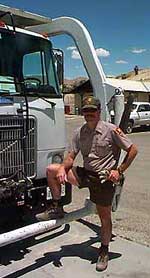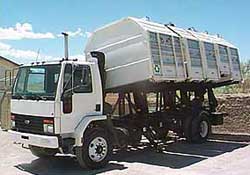People More People>
 "Death
Valley is huge. I get to work early, so I can walk around and see what's
here." At 6:01 a.m. Mark Holloway's workday has just officially begun
at the Cow Creek Maintenance Station near Furnace Creek in
Death Valley National Park, but he has been here for nearly an hour. His morning's
stroll led to a discovery of some old large cast-iron cooking pots in
the flats across from the maintenance station, west of California Hwy.
190. "I don't know if they washed down there in a flash flood or
were abandoned by some of the hundreds of travelers that have made their
way through this region."
"Death
Valley is huge. I get to work early, so I can walk around and see what's
here." At 6:01 a.m. Mark Holloway's workday has just officially begun
at the Cow Creek Maintenance Station near Furnace Creek in
Death Valley National Park, but he has been here for nearly an hour. His morning's
stroll led to a discovery of some old large cast-iron cooking pots in
the flats across from the maintenance station, west of California Hwy.
190. "I don't know if they washed down there in a flash flood or
were abandoned by some of the hundreds of travelers that have made their
way through this region."
Mark, 46, has enjoyed a remarkable range of employment options during his tenure as a Federal employee. As a young man, he served as a M551-Sheridan tank commander in the US Army, and later he became a civilian mechanic entrusted with the task of ensuring that the elite tanks and equipment at Ft. Irwin were kept in fighting trim. "Ft. Irwin is the home base to the 'top gun' training facility in the world of armored vehicles. It was my job to make sure all our vehicles could go just about anywhere." His early work must have instilled a permanent wanderlust that has led him to assignments driving vehicles and exploring back roads in Hot Springs National Park, Yosemite National Park and now Death Valley.
Today, I am joining Mark on a seven-hour ride-along as we pick up the week's trash using a front-loader trash hauler that empties the 60-odd 3-yard dumpsters found in the central areas of the park. This is my first time riding shotgun in a rubbish truck and Mark has warned me about the uncomfortable passenger seat and recent problems with the air conditioner. I know that the park recorded a 126-degree day only a few days ago, and I've brought extra water and the basic survival equipment I routinely carry whenever I go hiking. I caught Mark suppressing a slight grin when he saw all the gear I am attempting to arrange in my seating area. Despite his warnings, I found the seat reasonably comfortable and the air conditioning worked well all day. The mercury only reached a balmy 116 degrees (in the shade) that afternoon. We hit the road about 6:30 am, after Mark introduced me to some of the other personnel at the maintenance headquarters. I am a person who relishes sleeping in the cool, early morning hours, and I was surprised to learn that most of the maintenance and road crew staff have already worked two or three hours before I even wake up.
Mark was a veritable fountain of information about things to see and the cultural lore of the park. Although he has only been working at the park for about a year, it quickly became obvious that he takes all aspects of his job seriously and spends much of his free time exploring the park. He also performs an interpretative host role-- at one point we stopped to use a roadside "comfort station" where he checked on the condition of some guests from Ohio, making sure that they had sufficient water and offering them suggestions on places to visit while in the park.
Death Valley serves as the proving ground for a number of automotive trials. During our rounds, Mark pointed out some vehicles that GM has supplied to the Park Service to test new braking systems and one 4-wheel drive pickup whose bed is composed entirely of composite materials. Several automotive manufacturers also pay a commercial permit to the Federal government, which allows them to drive new vehicles on the public roads to test air conditioning and other vehicle systems in the extreme heat and cold and adverse highway conditions that occur in Death Valley throughout the year. As I left the park, I saw three new Honda CRV-like vehicles undergoing one such trial. They looked like just another set of tourists going down the road, except that all three cars were identical and traveling train-like without stopping to enjoy the views.
Mark's superb handling of that big trash truck was fun to observe-- I have a whole new level of appreciation for what it takes to skewer those trash bins, a skill we take for granted in urban settings. During the seven-plus hours I had occasion to travel with Mark, I doubt more than five minutes went by without him sharing another gem about life within the National Park system or some of the places in Death Valley my own wanderlust will now entice me to explore. I'll be back to check out:
- the boardwalk down by Salt Creek where hundred of the endangered pupfish are known to hang out
- the Sahara-like Eureka Dunes at the northern end of the park
- the pass beyond Wild Rose Ranger Station that leads to the Trona Pinnacles
- the old Inyo mine in Echo Canyon which was once owned by the Charles Schwab family
- the hundreds of miles of paved and dirt roads in the park.
 When
he is not working with the road maintenance crew or hauling rubbish, Mark
runs the recycling program for the Park. When he arrived nearly a year
ago, the previous employee in charge of the new high-tech recycling materials
truck had not left a manual or instructions on how to operate the complex
hydraulic systems of this vehicle. With typical ingenuity and determination,
Mark figured it out and demonstrated its use to me shortly before I left
to return to Pahrump.
When
he is not working with the road maintenance crew or hauling rubbish, Mark
runs the recycling program for the Park. When he arrived nearly a year
ago, the previous employee in charge of the new high-tech recycling materials
truck had not left a manual or instructions on how to operate the complex
hydraulic systems of this vehicle. With typical ingenuity and determination,
Mark figured it out and demonstrated its use to me shortly before I left
to return to Pahrump.
Mark is also a photographic contributor to RoadTrip America®. He and his wife Freda live in Beatty, Nevada, and frequently can be found exploring the back roads of the Southwest. The next time you are in Death Valley, look for the Park Service trash/recycling trucks and give Mark a friendly wave of thanks for me!
Mark
June, 2000
